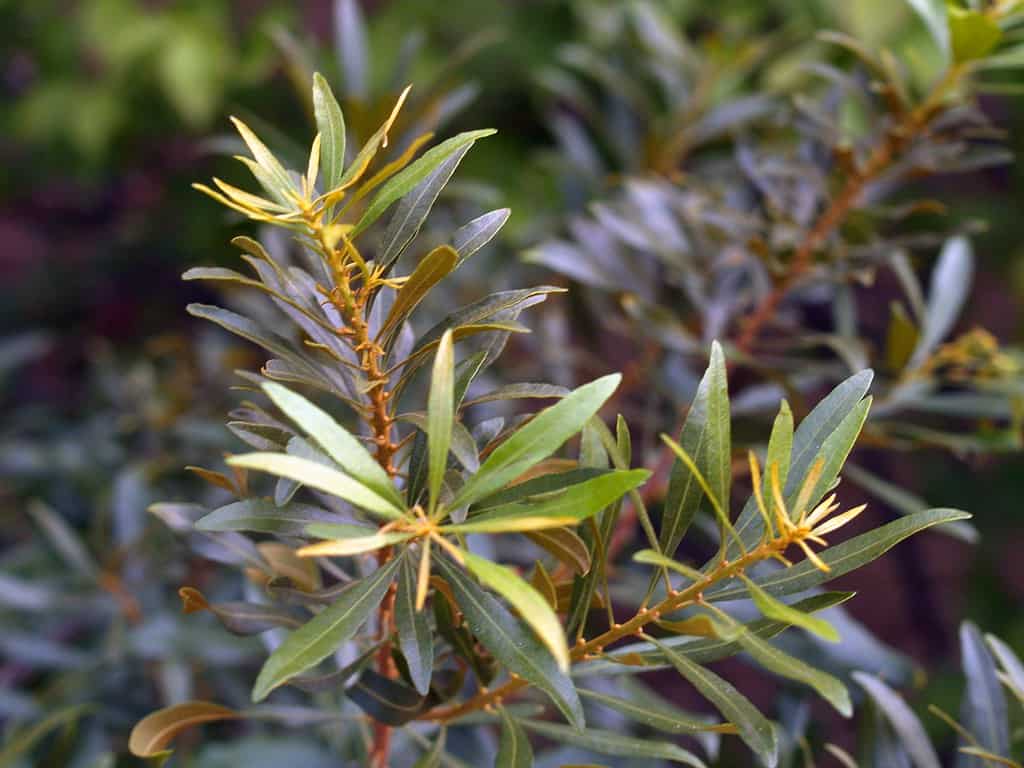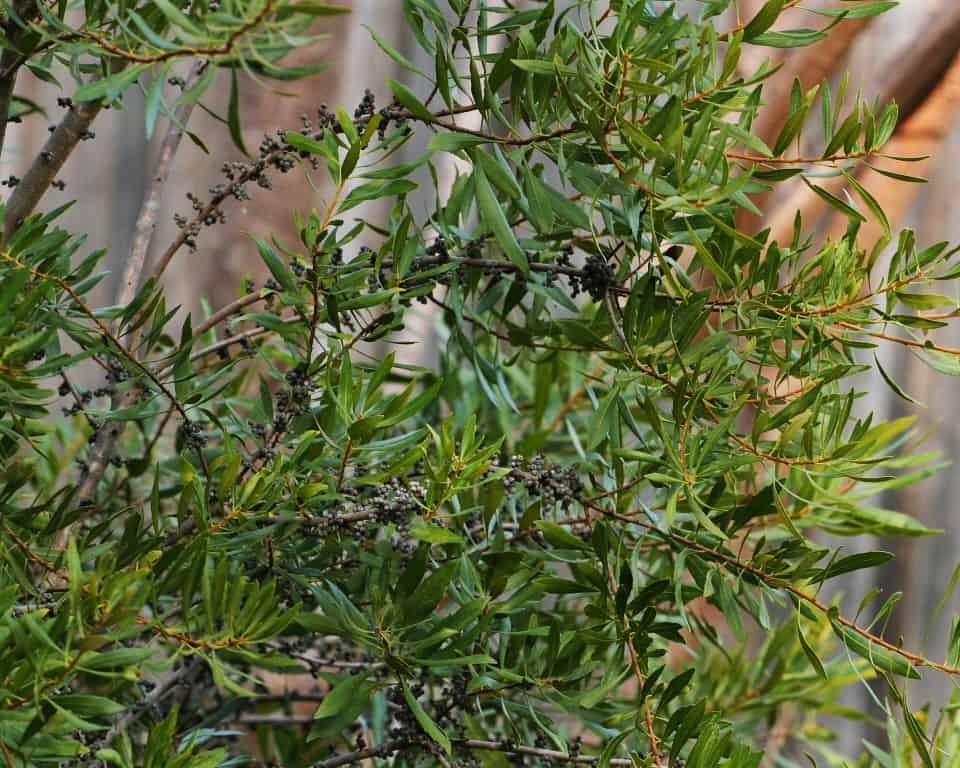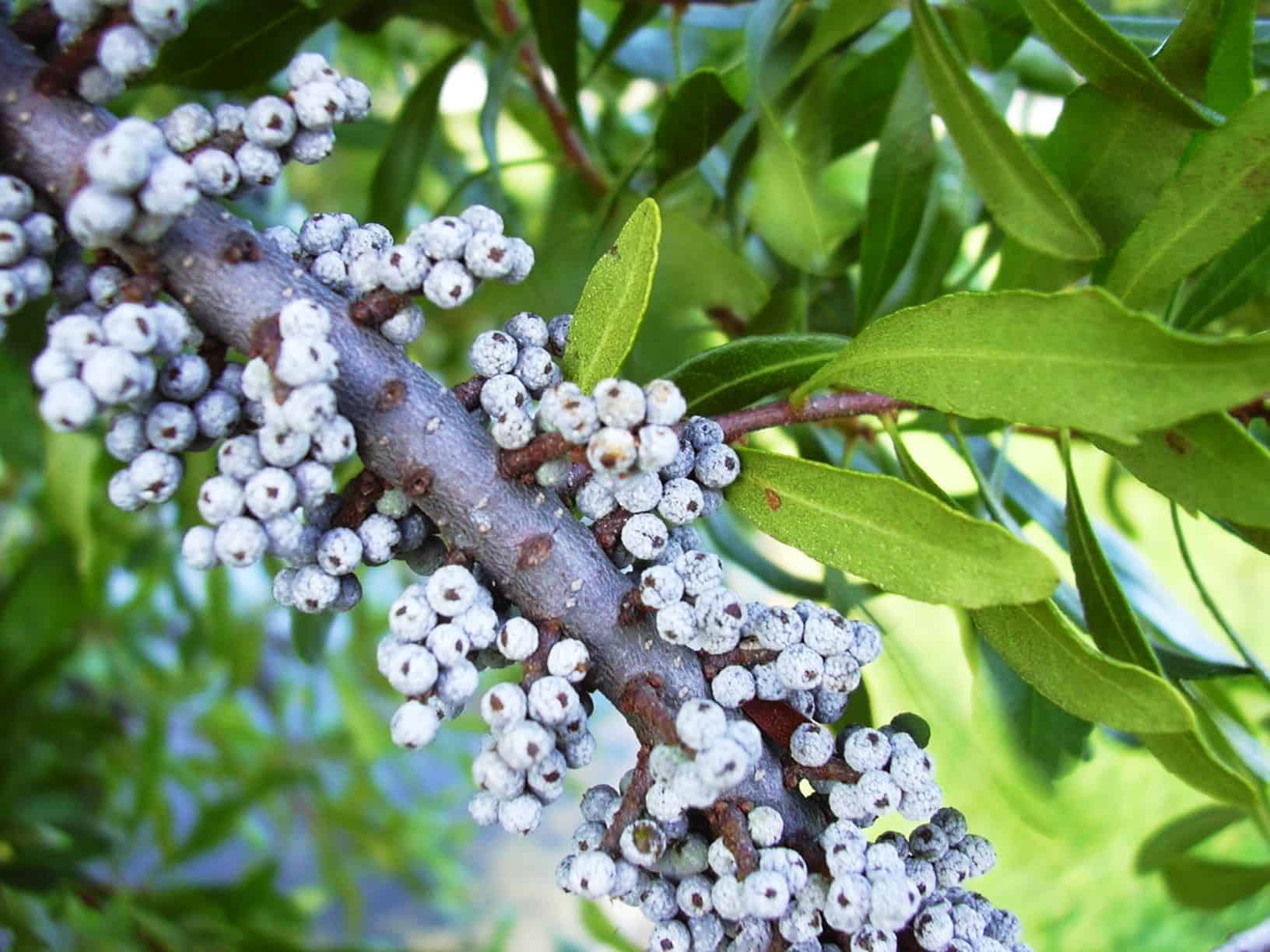No products in the cart.
Make the Myrica cerifera part of your landscape today. Why? The Wax Myrtle is an evergreen shrub that is an excellent addition to borders as a hedge and a fast-growing shrub. The other familiar name is the Southern Wax Myrtle, similar to the Northern Bayberry.
The main difference is it is a heat-loving species suitable to grow in warm climates.
More About The Southern Wax Myrtle
Okay, you may wonder why we said Myrica cerifera and not Morella cerifera. Well, it is the same outdoor plant known as Wax Myrtle. It recently was reclassified to the Morella genus but still belongs to the Myricaceae family.
The common names are:
Southern Bayberry
Dwarf Bayberry
Dwarf Wax-myrtle
Bayberry
Southern Wax Myrtle
Southern Wax myrtle
Tallow Shrubs
Wow, that is a mouthful, but the shrub can grow in the garden. The plant has narrow olive-green leaves, but leaf browning typically occurs when it becomes colder. The Morella cerifera can grow up to 15 feet tall and wide and sometimes up to 20 feet.
You can use it limbed up to form a small tree or form sizable colonies as a hedge or privacy screen. When new foliage grows, the leaves have a fragrance when crushed, smelling like berries. Hence, people use it to make Bayberry candles.
The plant also has a high salt spray tolerance and thrives in wet, swampy areas. The Tallow Shrub is ideal for pond margins and wetland gardens to help with erosion control. The opposite is it also works well in dry xeric uplands and fixes atmospheric nitrogen.
You find tiny yellow resin glands on the leaves; the barks are thin but smooth to gray-brown. During spring, male and female flowers bloom in a bluish-white color and mature into clusters formed on short stalks.
The blooms can last through winter; some cultivars are dioecious, while others are monoecious.
In some cases, you only find male or female plants that need to be planted close by to produce the waxy berries. The Morella cerifera are native plants in Central America found on the coastal plain stretching from Maryland to Texas.
Southern Bayberry Care Tips

Before we care for the Southern Wax Myrtle, this interesting plant can die in wildfires as the pale blueberries have an aromatic waxy substance with a distinctive Bayberry candle fragrance. But it does contain flammable aromatic compounds causing it to burn.
Still, the fantastic thing is it always seems to regrow from its root system after dying.
Furthermore, the plants are wind tolerant and cold hardy in the USDA zones 7 to 10.
A Note of Warning Planting Wax Myrtle as Shrub Borders
Before you decide to plant the Wax Myrtle in the garden, it is an invasive weed in certain parts of the United States. For example, you cannot grow it in Hawaii or Florida as it forms a dense thicket. In addition, the waxy coating on the berries is a potential fire hazard.
When planted in the landscape, care needs to be taken to ensure it does not escape as the seeds disperse quickly by birds to wildlife.
The Best Light Conditions For This Popular Ornamental Plant

When choosing a spot to grow your plant, it can grow in poor soils from full sun to partial shade. For example, when you grow Southern Bayberry in full sun, the foliage is dense compared to wet or shady sites. Still, the shrubs tend to need 4 to 5 hours of direct sunlight.
What Soil is Best For Morella Cerifera?
Your Wax Myrtle can initially grow in medium to wet soils, but the soil drainage needs to be good. Whether grown in a container or on the ground, provide it with well-draining soil and some organic matter like vermiculite, perlite, or coco coir.
Watering Southern Wax Myrtle

Your Morella cerifera needs constant moisture but should not become waterlogged. While it can grow in soil conditions ranging from dry to wet or shady sites, these plants might need constant moisture, but it is best to allow the soil to dry between watering.
Fertilizing Tallow Shrub
The Myrica cerifera is a light feed but can benefit from a feed. Using a slow-release fertilizer for trees or shrubs, you can fertilize your shrub in spring. Preferably use one containing Iron or Sulfur. Or you can use organic plant food instead.
Planting Southern Bayberry

The fantastic thing about Wax Myrtle is that you can grow them in containers and ground. One thing is for sure the olive green leaves with berries will always smell like Bayberry candles close by.
Ground planting
When you live in South Florida near the coasts, these native shrubs work well for coastal planting with their salt tolerance. The only thing is this plant cannot tolerate cold winters.
Dig a hole about two to three times wider but not deeper than the root ball. Place some soil you removed into the hole and add some sand or topsoil if the ground feels hard.
Remove your Wax Myrtle, loosen the feeder roots, and set it in the planting hole with the top of the root ball a bit above ground level. Backfill the soil as needed and tamp it to remove the air pockets.
Then soak the soil when reaching halfway and continue to the top edge of the root ball. Preferably do not place soil on top of the root ball, as it will suffocate the roots.
Water again, allowing the soil to level in with the roots, and once done, you can water the planting area. Then apply some shredded wood mulch or pine straw around your planting area.
Container planting
The soil needs to be consistently moist for growing in a pot as houseplants but drains well.
Place some shade cloth at the bottom of the pot to prevent the drainage holes from clogging up. Then remove your indoor plant from the nursery container and loosen the feeder roots.
Pour some soil mixture at the bottom and set the root ball in the center as with planting in the ground. Backfill to the edge of the root ball and water until it flows from the drainage holes. Add more soil allowing your plant to settle and water again.
Then apply some sphagnum moss or wood chips to the soil surface or stone mulch.
Pruning Wax Myrtle

The native plants respond well to pruning as a small tree or hedge for shaping purposes. You can do light pruning to remove damaged or stray branches any time of the year. The same applies to shearing them as hedges.
We recommend ceasing pruning at least two months before the first frost date. Then, you can prune your native shrubs to reduce their size in late winter while dormant. For selective pruning, use a bypass hand pruner to remove the limbs and hedge trimmers for hedges.
For forming small trees, it helps to wait until your shrub is about four feet tall to start. We recommend starting at the base and removing the horizontal branches that grow from the trunk. You can remove the branches until the required height is reached.
Propagating Wax Myrtle
There are different methods to propagate your Southern Bayberry: softwood cuttings, semi-hardwood cuttings, and seeds. You can sow seeds outdoors in the fall or stratify them. The wood cuttings you need to take in summer, while root cuttings are taken in early winter.

The root-cutting length needs to be about three inches long. You can collect seeds and leave the sealing wax on for storage. But remove the wax before the stratification. Next, remove the coating using a solution of one t. lye and one-gallon water. Then store in a sealed container in the refrigerator.
The stratification days are up to 90 days at 34° to 41°, but you can also buy seeds commercially. Another notable thing is having your shrub grow berries; you will need a male plant, and female plants close together to pollinate female flowers in some species.
Wax Myrtle Varieties
The Morella cerifera is mainly confused with the Myrica pensylvanica or Northern Bayberry, native shrubs to the eastern United States. It is a dioecious shrub with male and female flowers on separate plants. It produces gray berries used to make blueberry candles or soaps.
The evergreen shrub has a round growth habit that grows dense.
The pollinated female flowers develop into berries.
Common Pest and Diseases
While the wax-bearing plant is not susceptible to many pests and diseases, you must keep your eye on them like most other plants. Some concerns are leaf beetles known to feed on the foliage. Other concerns are leaf browning typically occurs in winter, and leaf anthracnose plus leaf mosaic.
The foliage turns to drab yellowish green, particularly the new growth. It will result in premature leaf drop.
Frequently Asked Questions
The shrub needs at least six hours of morning sun and partial shade in hot climates.
The shrubs grow best in medium to wet soils with good drainage. It can even tolerate salt spray.
These native shrubs can grow in part shade but do not tolerate freezing temperatures. As a result, the leaves will turn brown and fall off.
The plant you can find at a garden center or online. But you need not look far as Plantly has this shrub available for you to buy.
Whether you want to buy, sell or simply reach out to other plant enthusiasts, Plantly is the right place to be!


